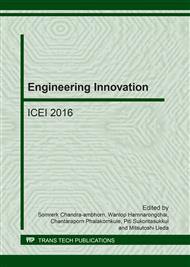[1]
N. Chaithanatkun, D. Chantarawong, P. Songkeaw, K. Onlaor, T. Thiwawong and B. Tunhoo, Electrical bistable properties of ZnO nanoparticles thin film prepared by electrostatic spray deposition technique, Proc. IEEE NEMS (2015) 152-155.
DOI: 10.1109/nems.2015.7147398
Google Scholar
[2]
A.N. Mallika, A.R. Reddy and K.V. Reddy, Annealing effects on the structural and optical properties of ZnO nanoparticles with PVA and CA as chelating agents, J. Advanced Ceramics. 4(2) (2015) 123-129.
DOI: 10.1007/s40145-015-0142-4
Google Scholar
[3]
C. Wu, X. Qiao, J. Chen, H. Wang, F. Tan and S. Li, A novel chemical route to prepare ZnO nanoparticles, J. Mater. Lett. 60 (2006) 1828-1832.
DOI: 10.1016/j.matlet.2005.12.046
Google Scholar
[4]
K.P. Raj and K. Sadayandi, Effect of temperature on structural, optical and photoluminescence studies on ZnO nanoparticles synthesized by the standard co-precipitation method, J. Physica B. 487 (2016) 1-7.
DOI: 10.1016/j.physb.2016.01.020
Google Scholar
[5]
R.K. Sendi and S. Mahmud, Impact of sintering temperature on the structural, electrical, and optical properties of doped ZnO nanoparticle- based discs, J. Appl. Surf. Sci. 261 (2012) 128-136.
DOI: 10.1016/j.apsusc.2012.07.115
Google Scholar
[6]
H.R. Ghorbani, F.P. Mehr, H. Pazoki and B.M. Rahmani, Synthesis of ZnO Nanoparticles by precipitation Method, J. Orient Chem. 31(2) (2015) 1219-1221.
DOI: 10.13005/ojc/310281
Google Scholar
[7]
T.M. Hammad, J.K. Salem and R.G. Harrison, The influence of annealing temperature on the structure, morphologies and optical properties of ZnO nanoparticles, J. Superlattice. Microst. 47 (2010) 335-340.
DOI: 10.1016/j.spmi.2009.11.007
Google Scholar
[8]
S.S. Kumar, P. Venkateswarlu, V.R. Rao and G.N. Rao, Synthesis, characterization and optical properties of zinc oxide nanoparticles, J. Int. Nano Lett. 3 (2013) 30.
DOI: 10.1186/2228-5326-3-30
Google Scholar
[9]
N.A. Salahuddin, M.E. Kemary and E.M. Ibrahim, Synthesis and Characterization of ZnO Nanoparticles via Precipitation Method: Effect of Annealing Temperature on Particle Size, J. Nanoscience and Nanotechnology. 5(4) (2015) 82-88.
Google Scholar
[10]
M.R. Parra and F.Z. Haque, Aqueous chemical route synthesis and the effect of calcination temperature on the structural and optical properties of ZnO nanoparticles, J. Mater. Res. Tech. 3(4) (2014) 363-369.
DOI: 10.1016/j.jmrt.2014.07.001
Google Scholar
[11]
A.K. Zak, W.H. Abd. Majid, M.E. Abrishami and R. Yousefi, X-ray analysis of ZnO nanoparticles by Williamson-Hall and size-strain plot methods, J. Solid State Sci. 13 (2011) 251-256.
DOI: 10.1016/j.solidstatesciences.2010.11.024
Google Scholar
[12]
S.S. Kanmani, K. Ramachandran and S. Umapathy, Eosin Yellowish Dye-Sensitized ZnO Nanostructure-Based Solar Cells Employing Solid PEO Redox Couple Electrolyte, International Journal of Photoenergy. 2012 (2012) Article ID 267824, 8 pages.
DOI: 10.1155/2012/267824
Google Scholar
[13]
R. Cusco, E.A. Llado, J. Ibanez, L. Artus, J. Jimenez, B. Wang and M.J. Callahan, Temperature dependence of Raman scattering in ZnO, J. Phys. Rev. B. 75 (2007) 165202.
DOI: 10.1557/proc-0957-k07-11
Google Scholar
[14]
T. Gutul, E. Rusu, N. Condur, V. Ursaki, E. Goncearenco and P. Vlazan, Preparation of poly(N-Vinylpyrrolidone)-stabilized ZnO colloid nanoparticles, J. Nanotechnology. 5 (2014) 402-406.
DOI: 10.3762/bjnano.5.47
Google Scholar
[15]
M. Kooti and A.N. Sedeh, Microwave-Assisted Combustion Synthesis of ZnO nanoparticles, Journal of Chem. 2013 (2013) Article ID 562028.
Google Scholar


